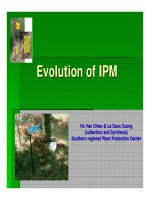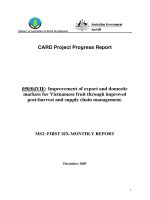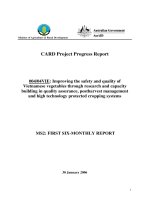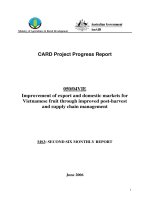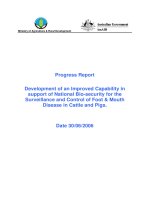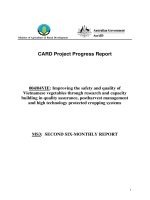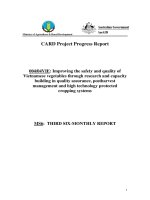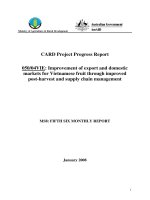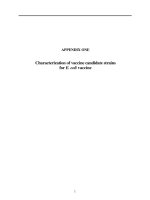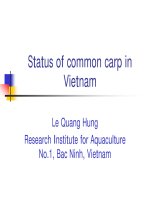Báo cáo nghiên cứu khoa học " Improvement of export and domestic markets for Vietnamese fruit through improved post-harvest and supply chain management - Milestone 9 Report " pdf
Bạn đang xem bản rút gọn của tài liệu. Xem và tải ngay bản đầy đủ của tài liệu tại đây (97.38 KB, 25 trang )
1
Ministry of Agriculture & Rural Development
CARD Project 050/04VIE
Improvement of export and domestic
markets for Vietnamese fruit through
improved post-harvest and supply chain
management
Milestone 9 Report
July 2009
1
Table of Contents
1 Institute Information 2
2 Contact Officer(s) 3
3 Project Abstract 4
4 Executive Summary 4
4.1 Introduction & Background 6
4.2 Implementation Highlights 7
4.3 Small holder Benefits and Capacity Building 14
4.4 Publicity 16
4.5 Project Management 19
5 Report on Cross-Cutting Issues 19
5.1 Environment 19
5.2 Gender and Social Issues 21
6 Implementation & Sustainability Issues 21
6.1 Issues and Constraints 21
6.2 Options 22
6.3 Sustainability 23
7 Next Critical Steps 24
8 Conclusion 24
2
1 Institute Information
Project Name Improvement of export and domestic
markets for Vietnamese fruit through
improved post-harvest and supply chain
management.
Vietnamese Institution Southern Sub-Institute of Agricultural
Engineering and Post-Harvest Technology
(SIAEP)
Vietnamese Project Team Leader Mr Nguyen Duy Duc, M. Eng.
Australian Organisation Queensland Department of Primary
Industries and Fisheries (DPI & F)
Australian Personnel Mr. Robert Nissen
Dr. Peter Hofman
Mr Brett Tucker
Mr. Roland Holmes
Date commenced September 2006
Completion date (original) May 2008
Completion date (revised) December 2008
Reporting period Milestone Report 7
3
2 Contact Officer(s)
In Australia: Team Leader
Name: Mr. Robert Nissen Telephone: +61 07 54449631
Position: Project Leader Fax: +61 07 54412235
Organisation Queensland Department of
Primary Industries and Fisheries
(DPI & F)
Email:
In Australia: Administrative contact
Name: Michelle Robbins Telephone: +61 07 3346 2711
Position: Senior Planning Officer
(Emerging Technologies)
Fax: +61 07 3346 2727
Organisation Queensland Department of
Primary Industries and
Fisheries (DPI & F)
Email:
In Vietnam
Name: Mr Nguyen Duy Duc, Telephone: +84 (8) 8481151
Position: Director SIAEP Fax: +84 (8) 8438842
Organisation Southern Sub-Institute of Agricultural
Engineering and Post-Harvest
Technology (SIAEP)
Email:
4
3 Project Abstract
4 Executive Summary
The implementation of “doi moi” and poverty reduction policies by the Vietnamese Government
have made significant progress in reducing poverty. The poverty rate in the Mekong Delta is still at
13.3% with a further 20% of households living just above the poverty line. The current recession
could see a change in poverty rates, with people migrating from the cities back to their families in
the country due to a downturn in employment opportunities.
Farmers with higher education levels appear to be able to understand production problems and
apply new technologies to solve those problems, whilst farmers with lower education levels
implement traditional farming practices and hope the problems that they face will be solved by
someone else.
About 40 per cent of the Mekong Delta is affected by acid sulphate soils (ASS). Disturbance of ASS
through land clearance, drainage, tillage and mounding can cause acid runoffs into the aquatic and
marine environment, either killing fish or increasing the incidence of disease in the marine
population. Saline soils also present further constraints to agricultural development and are located
primarily in the coastal zone. Development of new, and re-establishment of existing orchards, will
require soil to be either moved or disturbed, and a management plan will be needed to eliminate the
runoff of acid or nutrients in the environment.
Overuse and use of incorrect chemicals will have a significant impact on obtaining GAP and quality
assurance for mango and pomelo in the Mekong Delta for both domestic and export markets.
Environmental issues identified during consultation with farmers during this CARD Project
participatory action learning workshops were:
• contamination of irrigation water (salt and grey water)
The fruit industry in Vietnam has a great potential and plays an important role in agricultural
production. In 2003, Vietnam exported US$43 million of high value fruit to high-income countries
and imported US$14 million of fruit and vegetables. Vietnam is experiencing difficulties in
competing with other Asian nations in export markets and its own domestic market, especially with
China and Thailand. This suggests that Vietnam’s horticultural industries require substantial
development to be globally competitive. Vietnamese consumers are demanding safer and higher
quality fruit. This project has identified key pre-and post-harvest technology gaps that reduce
product quality, safety and consistency. Targeted training programs are focusing on the total
supply chain and are providing benefits by helping to implement quality management systems and
GAP systems at the village level providing greater employment for the farming community. This
project embraces the five CARD strategies for rural development; and in particular; strategies to
increase production and competitiveness of agricultural systems; reduce poverty and vulnerability,
and increase stakeholder participation whilst ensuring sustainability.
5
• disposal of grey water and by product contamination of waterways
• agricultural spray application methodology and practices
• type and amount of fertiliser, their application methods to reduce environmental
contamination
• mixed farming methodology and cultural practices (mixed plant and animal farming
practices)
In Vietnam, there is a significant need to develop small and medium sized agricultural enterprises.
Areas of significant need for developing small and medium agricultural enterprises are:
1. Marketing and trade development
• Training on understanding supply/value chains:- They need to understand all the
participants and the roles they play in a supply/value chain (domestic and export)
• Training on how to develop and establish a supply/value chains:- Understand the
supply/value chain development process, then build their own supply/value chain to
create improved value for all the chain members.
• Market analysis and development:- Understand their market; segment their market;
adjust their product to their target market segment; develop new products.
2. Technology areas including plant and equipment
• Information on new technologies
• Implementation of new technologies
• Access to new technological equipment to create added value
• Efficiencies in use of equipment (reduction in idle time)
3. Business development
• Establishment of associations:- Codes of conduct, rules and membership etc.
• Development of the business model:- Setting up the business; Structuring the
business:-Business plan, including marketing plan and financial plan etc.
• Training and development of entrepreneurial skills
For mango, farmers who still use the traditional supply/value chain system receive a net return of
about 6,514 VND (A$0.45) per kg of fruit. Farmers who implemented new GAP systems and
develop new markets achieve net returns of about 15,423 VND (A$1.07) per kg of fruit. Farmers
who joined a cooperative and implemented GAP and best practice, plus develop new markets
achieve net returns of about 21,793 VND (A$1.51) per kg of fruit. By being in a cooperative,
farmers can substantially reduced costs of implementing GAP systems and developing new
markets in HCMC.
Comparison of mango to rice farming in the Mekong Delta indicates that horticultural crops provide
significantly higher returns. For example:- rice farmers in the Mekong Delta grown on average two
rice crops per year. The average yield is about 4.8 tonnes per hectare with a net income of 3,652
VND per kg of rice (Berg 2002, pp.100 and 102). Therefore, farmers of Cat Hoa Loc Mango
receive a seven fold increase in net returns compared to rice farmers in the Mekong Delta of
Vietnam.
Mango fruit bagging, increased fruit quality, decreased losses due to pests and diseases and
increased the farm gate returns. The increased benefit farmers receive by fruit bagging a 10 year
old mango trees was 645,000 VND/tree for the secondary crop.
6
Pruning and training (Canopy management) of Cat Hoa Loc mango trees increased yield, obtained
better commercial quality fruit and reduced input costs such as chemicals, spray application and
labour costs. In the off season, pruned orchards benefited by 10,420,016 VND/1,000m
2
or 3.4
times more profitable compared with traditional orchard canopy management methods.
Organic fertilising use in Nam Roi pomelo production achieved higher yields, better quality fruit and
saved on fertiliser costs. Tree health improved and the production life of the tree also increased.
Farmers using organic methods benefited by 2,390,000 VND / 1,000m
2
or 1.7 times more profitable
compared to inorganic methods.
The retail scene, especially in Ho Chi Minh City, is undergoing a great deal of change that is
beginning to benefit the end consumer. Retailers of Ho Chi Minh City reported that consumers are
becoming more fastidious on choosing fruit. Supermarkets and department stores have grown in
number, and many are modernising their services and products to boost sales and their
competitiveness.
Both vertical and horizontal integration of a supply chains has to occur if chains are to be effective
and efficient. Whilst all participants involved in these strategic supply chain development
processes find it easy to analyses their existing chains and develop new chains, the underlying
principles of developing high levels of trust, open effective communication and information flows
are very difficult to achieve due to the business culture operating in these transitional economies.
4.1 Introduction & Background
Ford et al., (2003) analysed the competitiveness of fruit industries in Vietnam and identified:
• poor unstable product quality
• no quality standards
• poor post harvest technologies
• poor pre-harvest practices
• lack of group co-operative marketing structures
• little information about supply chains, prices and customers needs.
Stakeholder/beneficiary analysis of fruit crops in the Mekong delta showed that both mango and
pomelo (with plantings of 33 000 ha and 9 000 ha, respectively) are very important fruit crops in
Southern Vietnam. The objectives of this CARD project 05/04 VIE are to:
• Improved pre-harvest technologies to produce high quality mango (integrated pest
management, integrated crop management, fruit fly control, maturity indices, reduced
pesticide residues, better environmental and human health etc)
• Improve mango and pomelo post-harvest technologies (eg, cool chain management,
packaging, post-harvest dipping, ethylene ripening, waxing, washing and wetting agents,
quality assurance)
• Improve quality standards and quality assurance programs for mango and pomelo. The
approach and methodologies developed for these crops through this project will be
applied to other fruits and vegetables.
7
• Map current supply chains to domestic and selected export markets, with particular
emphasis on determining consumer preferences and needs, and reporting results back
to farmers.
• Provide a better understanding and possible improvements of the supply chain by
Vietnamese fruit industries for mango and pomelo.
This CARD project fills capacity gaps and reduces major weaknesses in pre-and post-harvest
technologies affecting product quality consistency and supply chain management and planning.
Highly specialised targeted training programs and research appropriate for institutions and industry
stakeholders was provided to complete CARD Project 050/04 VIE Milestone 7.
CARD Project Milestone 9:- Improve supply chains operational for selected fruits. The deliverables
for Milestone 9 are:
• Documentation of improved quality, quantity and value obtained by cluster groups,
including documentation of reduction in post-harvest losses.
• Analysis of socioeconomic benefits and sustainability of project outcomes, including
revenue streams, use of appropriate packaging and village employment.
4.2 Implementation Highlights
To complete the requirements of Milestone 9 above by documenting fruit quality, quantity and
value obtained by cluster group’s surveys were conducted on the mango and pomelo supply
chains operating in the Mekong Delta of Vietnam and analysis of the economic and socioeconomic
benefits carried out. These results are presented in the ten reports listed below.
1. Report on Investigations into Mango Supply Chains in the Mekong Delta Vietnam 2005-
2007.
2. Investigation into the Pomelo Supply Chain in the Mekong Delta in Vietnam.
3. Fruit Quality Comparisons of Three Cat Hoa Loc Mango Supply Chains in Southern
Vietnam.
4. Maintaining Fruit Quality and Increasing Shelf Life of Pomelo in the Mekong Delta of
Southern Vietnam.
5. Study on economics and socioeconomics of small scale mango farming and cooperatives
in the Mekong River Delta, Vietnam.
6. Efficiency Evaluation of Pruning and Training in Cat Hoa Loc Mango Production.
7. Economic Evaluation of Fruit Bagging for Cat Hoa Loc Mango Production.
8. Economic Evaluation of Organic Fertiliser in Nam Roi Pomelo Production.
9. Mango Strategic Plan Development by Project Participants in the Mekong Delta of
Vietnam.
10. Pomelo Strategic Plan Developed by Project Participants in the Mekong Delta of Vietnam.
Reports 1, 2, 9 and 10 provide an assessment and overview of the mango and pomelo
supply/value chains operating in Southern Vietnam. Reports 3 and 4 are the results of the
reduction in postharvest losses and increases achieved in fruit quality. Report 5 are studies
conducted on the socioeconomic and economic benefits of the cluster group marketing Cat Hoa
8
Loc mango in the Mekong Delta of Vietnam by implementing pre-harvest and postharvest systems.
Reports 6, 7 and 8 evaluate the economics of changing pre-harvest aspects to increase fruit
quality, quantity and value obtained by farmers in the Mekong Delta of Vietnam.
Investigations into Mango Supply Chains
The retail scene, especially in Ho Chi Minh City, is undergoing a great deal of change that is
beginning to benefit the end consumer. Retailers of Ho Chi Minh City reported that consumers are
becoming more fastidious on choosing fruit. Supermarkets and department stores have grown in
number, and many are modernising their services and products to boost sales and their
competitiveness.
The mango variety ‘Cat Hoa Loc’ was the most popular variety and it could be purchased
anywhere in Ho Chi Minh City at any time for reasonable prices, even for the poor. Survey data
indicated that prices did not fluctuate widely over the seasons for the years 2005 to 2006.
Most consumers select fruit on colour and appearance with uneven ripening and fruit quality being
the greatest concerns for consumers. Consumers indicated that they would prefer a mango fruit
that is sweeter, has a smaller seed, is more fragrant, and has a longer shelf life.
Retailers sold the mango variety ‘Cat Hoa Loc’ during the main season for 50% more than the
purchase price and for 140% more than the purchase price during the off season.
Terms of trade and verbal agreements with collectors and farmers need to be quickly overhauled
and a new system put in place that protects the wholesaler, collector and farmer. Even though this
supply chain appears to be a model of efficiency, the inability of wholesalers and exporters further
down the chain to meet price and quality demands points to a significant problem. Also risks faced
by supply chain participants are significant. For example one collector/wholesaler/exporter is owed
a significant amount of money, some 49,000,000 VND after exporting mango fruit. Their options
are extremely limited in options to receive payment for fruit all ready supplied. Many collectors,
wholesalers, traders, transporters and middlemen act in an opportunistic way in order to minimise
the risk of opportunism, resulting in less-than-desirable supply chains. Weaknesses in the
Vietnamese legal system fail to address oblivious and dubious transactions, adding to less than
desirable supply chains operating in Southern Vietnam.
Fruit losses along the supply chain can be high, due to farmers not applying any post-harvest
practices such as culling damaged fruit. Fruit are continually graded as they move along the
supply chain, significantly reducing the effectiveness and efficiency of a supply chain. This also
impacts heavily upon the cost to supply quality fruit to the consumer.
Artificial ripening of mango using Calcium Carbide can be hazardous to human health. Excessive
use of calcium carbide can result in direct contact with fruit, causing contamination. Calcium
carbide can produce carcinogenic compounds and may contain other compounds such as arsenic
or produce phosphorus hydrides, causing serious health issues. Ethrel is a considerably safer
chemical and ethylene released is highly effective in ripening mangoes.
9
Prior to developing supply chain maps for mango and polmelo farmers in the Mekong Delta in
southern Vietnam, many chain participants felt that they had an excellent product, but data
collected from supply chain sampling revealed losses of up to 40% for mango and 30% for pomelo.
This mapping revealed that losses were due to incorrect handling procedures, no cool chain, poor
packaging, inadequate transport and stacking systems employed. This indicated a lack of
infrastructure, knowledge and skills along the supply chain.
Both vertical and horizontal integration of a supply chains has to occur if chains are to be effective
and efficient. Whilst all participants involved in these strategic supply chain development process
find it easy to analyses their existing chains and develop new chains, the underlying principles of
developing high levels of trust, open effective communication and information flows are very
difficult to achieve due to the business culture operating in these transitional economies.
Investigations into Pomelo Supply Chains
Many farmers are now realising that pomelo is a perishable fruit and traditional chains may have to
change. Farmers, wholesalers and collectors at the district level are starting to sell directly to
supermarkets and high quality retail shops in HCMC. No fruit class and quality standards exist for
many of the supply chains. Opportunistic marketing practices by collectors and wholesalers are
evident (Quinn et al., 2006). Verbal agreements between chain participants are not strictly
enforced or adhered due to a less than desirable legal system. Problems with traditional
procurement supply chain practices include low- or no product standards, supply inconsistencies,
highly variable transaction costs and limited or sequestered market information.
Even though Vietnam has had a significant increase in the number of hectares planted to pomelo
since 2004, domestic consumption has also increased and absorbed this increase in production.
Mixed farming systems and small scale planting of pomelo are causing yields and fruit quality to be
low, thereby reducing Vietnam ability to tap into new emerging export and domestic markets.
Traditional pomelo supply chains in southern Vietnam are long in terms of number of participants
and number of times fruit are handled compared to developed countries. Almost 80% of the fruit is
moved from farms to the collectors to local wholesale markets by boat. Fruit are usually stacked in
the bottom of boats with little or no protection from contamination.
High quality, extra or super class fruit, class 1 fruit are marketed with stalks attached. This is done
to reassure customers that the fruit they are purchasing fresh pomelo. These stalks often break off
during handling and transport and also draw moisture from the fruit. Farmers, collectors, traders,
packaging agents and wholesalers estimates of damage fruit is from fro 1 to 2%, but surveys found
it is often above 10%.
Supermarkets are now setting new procurement practices and supply systems which focus on
reducing costs and improving quality to enable them to sell at lower prices. This will allow them to
win over consumers and obtain a larger share of their target market. The ability of many small
farmers, collectors and wholesalers in the Mekong Delta of Vietnam to meet safe food levels and
quality demands of domestic and overseas supermarkets can only be obtained through investing in
improvements in their production and supply chain practices.
10
Fruit quality comparison of mango supply chians
Mango fruit quality was compared along three different supply chains, these were traditional, new
and a metro cool chain. We found that keeping mango fruit cool along the supply chain reduced
fruit weight loss by 35% to 61% and extended the shelf life by 4 days. Implementation of a new
packaging (fibreboard carton), hot water dipping and cooling of the fruit as along the supply chian
reduced disease infestation by 55% to 93%. A cool mature green mango can withstand handling
without being damaged but if temperatures are too high, handling damages will significantly
increase the incidence of disease. Mangoes should also be ripened at 18 to 22 to allow fruit to
develop maximum colour flavour, texture, and limit the loss of Vitamins.
Maintaining pomelo fruit quality and increasing shelf life.
All of the farmers, collectors, traders, packing agents, wholesalers, retailers and consumers use
colour as one of the indicators of maturity in the Mekong River Delta of southern Vietnam. Our
CARD Project research found that skin colour is not a good indicator of Nam Roi pomelo fruit
maturity. All citrus are non-climacteric fruit, meaning that they ripen gradually over weeks or
months. The best indices of maturity for citrus are internal Total Soluble Solids (
o
Brix or sugar),
Titrateable acid content (acid), and the
o
Brix/acid ratio which has been well established in the
literature and used by many countries including Australia and the United States of America as a
test of maturity and harvest index. The
o
Brix or sugar and acid content continued to increase in
Nam Roi pomelo fruit even after the fruit were harvested. This may be due to the significant
moisture loss which occurs within the pomelo fruit after harvest and the concentration of sugars
and acid in the fruit.
Comparing our Control treatment to the Vacuum Wrapping and Citra Shine Special Wax
treatments, we found that the Citra Shine Wax significantly reduced fruit moisture lost. Pomelo fruit
treated with Citra Shine Special Wax increased the shelf life of pomelo fruit based on fruit colour.
The increase was about 2 weeks compared to the control and Vacuum Wrapping treated fruit.
Citra Shine Special Wax also caused a delay in fruit colour from green to yellow. The delay was
about one week compared to the control and Vacuum Wrapped fruit.
Taste evaluations showed that the fruit treated with Citra Shine Special Wax were significantly
better than the Control and Vacuum Wrapping treated fruit. At day 63, the Citra Shine Special Wax
treated fruit rated at 5.5 (neither liked nor disliked), whilst the Control and Vacuum Wrapping
treated fruit rated 1, (disliked very much).
Further studies are needed to test the effectiveness of Vacuum Wrapping and Citra Shine Special
Wax treated fruit on cool chain exported pomelo fruit as there may be additional benefits in
delaying the ripening process and increasing the shelf life.
Socioeconomic studies of mango and pomelo supply chains in southern
Vietnam
Socioeconomic Issues
Demographics
11
The average population growth rate in Vietnam in the early 1990’s was 3.5%, but it is now slowing
to 1.35%. This may be due several factors; a decreased in fertility rates and better education
provided to the ethnic minority groups who traditionally had large families and an increase in living
standards has reduced fertility rates. Comparing Vietnam’s population growth rate of 1.35% to the
Mekong Delta population growth rate of 2% the Mekong Delta is 0.65% above average.
Poverty
The implementation of “doi moi” and poverty reduction policies by the Vietnamese Government
have made significant progress in reducing poverty. The average poverty rate in Vietnam is now
19%. The poverty rate in the Mekong Delta is still at 13.3% with a further 20% of households living
just above the poverty line. This economic recession could see a change in poverty rates as
people are migrating from the cities back to their families in the country due to a downturn in
employment opportunities.
The Mekong Delta Economic Cooperation stated that the Mekong Delta provides 90% of rice
exports, 70% of fruit production and 60% of aquatic products exported from Vietnam. Therefore,
whenever people mention to the Mekong Delta, they usually mention its advantages only. People
usually consider the Mekong Delta region as a "rich food but poor knowledge" region. Education
and training of people is low in the Mekong Delta. For example, the number of regional students
studying in the vocational schools is at the lowest rate. The Mekong Delta has a low intellectual
standard compared with the whole country. The Mekong Delta has not reached its full potential
and regional agricultural production is unsustainable and poverty rate will increase if this continues.
Farmers with higher education levels appear to be able to understand problems and apply new
technologies to solve those problems, whilst farmers with lower education levels implement
traditional farming practices and hope the problems that they face will be solved by someone else.
Environment
About 40 per cent of the Mekong Delta is affected by acid sulphate soils (ASS). Disturbance of ASS
through land clearance, drainage, tillage and mounding can cause acid runoffs into the aquatic and
marine environment, either killing fish or increasing the incidence of disease in the marine
population. Saline soils also present further constraints to agricultural development and are located
primarily in the coastal zone. Development of new, and re-establishment of existing orchards, will
require soil to be either moved or disturbed, and a management plan will be needed to eliminate the
runoff of acid or nutrients in the environment.
Farm design
Good farm and orchard design is essential to ensure any water, fertiliser, chemicals and soil runoff
is trapped on farm. This is an essential element of GAP. This element is often overlooked or
neglected due to the cost of re-establishing an orchard or loss of viable producing area to ensure
the environment is protected. There are no incentives or subsidies and farmers are forced to cover
these costs out their own pocket, reducing their viability even though there are wider social,
ecological and environmental benefits, such as reduced incidences of contractible diseases,
cleaner environment (fewer pollutants) and a healthier life for the community from such practices.
Chemicals
Farmers and other pesticide users usually ignore the risks, safety instructions and essential
protective measures in using chemicals. Records showed that 11% of all poisonings in the country
12
are due to pesticides: approximately 840 poisonings in 53 cities and provinces in 1999 in Vietnam.
Surveys conducted by the Plant Protection Department have shown that 80% of farmers in the
South of Vietnam consider pesticide application the essential component of the production system
compared with other control practices. Overuse and use of incorrect chemicals will have a
significant impact on obtaining GAP and quality assurance for mango and pomelo in the Mekong
Delta for both domestic and export markets.
Farmer Issues
Environmental issues identified during consultation with farmers during this CARD Project
participatory action learning workshops were:
• contamination of irrigation water (salt and grey water)
• disposal of grey water and by product contamination of waterways
• agricultural spray application methodology and practices
• type and amount of fertiliser, their application methods to reduce environmental
contamination
• mixed farming methodology and cultural practices (mixed plant and animal farming
practices)
Poor agricultural practices can create serious problems in the Mekong Delta and contamination of
land and waterways through:
• soil management and disturbance (particularly acid sulphate soils (ASS))
• incorrect water management and irrigation systems
• incorrect and constant use of agricultural chemicals (insecticides, growth regulators etc.)
• incorrect use of fertilisers (both organic and inorganic)
This may lead to:
• increased salinity
• decrease in productivity of crops and local aquaculture
• spread of contaminants, poisoning and increase of infectious diseases with in the local
community
• damage to the local ecology
• and loss of employment through reduced productivity
Enterprise development
In Vietnam there is a significant need to develop small and medium sized agricultural enterprises.
Many farmer groups are trying to develop and establish small and medium agricultural enterprises
(farmer groups or cooperatives). These groups face many difficulties. One major hurdle is the
borrowing of money from banks to expand or extend their operations. Banks prefer to lend to state
owned enterprises. Due to Vietnam’s population being predominately rural, there is an urgent
need to facilitate this development via a sustainable socioeconomic approach.
Areas of significant need for developing small and medium agricultural enterprises are:
1. Marketing and trade development
• Training on understanding supply/value chains:- They need to understand all the
participants and the roles they play in a supply/value chain (domestic and export)
13
• Training on how to develop and establish a supply/value chains:- Understand the
supply/value chain development process, then build their own supply/value chain to
create improved value for all the chain members.
• Market analysis and development:- Understand their market; segment their market;
adjust their product to their target market segment; develop new products.
2. Technology areas including plant and equipment
• Information on new technologies
• Implementation of new technologies
• Access to new technological equipment to create added value
• Efficiencies in use of equipment (reduction in idle time)
3. Business development
• Establishment of associations:- Codes of conduct, rules and membership etc.
• Development of the business model:- Setting up the business; Structuring the
business:-Business plan, including marketing plan and financial plan etc.
• Training and development of entrepreneurial skills
Economic Analysis of Mango Cat Ho Loc Supply Chains
Farmers who still use the traditional supply/value chain system receive a net return of about 6,514
VND (A$0.45) per kg of fruit. Farmers who implemented new GAP systems and develop new
markets achieve net returns of about 15,423 VND (A$1.07) per kg of fruit. Farmers who joined a
cooperative and implemented GAP and best practice, plus develop new markets achieve net
returns of about 21,793 VND (A$1.51) per kg of fruit. They receive a 3 fold increase by being in a
cooperative if they implementing GAP systems including best practice pre- and post- harvest
systems and developing new marketing supply/value chains to HCMC as part of the cooperative.
By being in a cooperative will substantially reduce the costs of implementing GAP systems and
developing new markets in HCMC.
These new GAP and quality assurance systems are based on:-
• New harvesting and handling methods, using lined baskets, lowering fruit from trees, no
throwing or dropping or hand picking of fruit, clippers with bags used to harvest fruit,
cutting fruit with long stalks, clipping fruit stalks short and allowing fruit stems to suberise
eliminating sap burn by stopping sap dripping onto fruit
• Quality assurance manuals develop showing maturity indicators, fruit grade, size grades,
and allowable blemishes and adhering to these standards
• Post harvest techniques such as, sanitisation, hot water dipping to eliminate disease
incidence, grading and packaging tables
• Packing of fruit into fibreboard boxes to eliminate fruit bruising and contaminants and
damage
• Placing fruit into cool rooms and using ripening rooms
• Employment of trained graders and packers to ensure quality in the packing shed at the
village level
Comparison of mango to rice farming in the Mekong Delta indicates that horticultural crops provide
significantly higher returns. These returns are achieved by using new GAP systems and per- and
post- harvest best practice methods with access to new high value domestic markets in the major
cities of Vietnam.
14
For example:- rice farmers in the Mekong Delta grow on average two rice crops per year. The
average yield is about 4.8 tonnes per hectare with a net income of 3,652 VND per kg of rice (Berg
2002, pp.100 and 102). Therefore, farmers of Cat Hoa Loc Mango receive a seven fold increase in
net returns compared to rice farmers in the Mekong Delta of Vietnam.
Economic Studies of pre-harvest factors affecting mango fruit quality and yield.
Economic studies were undertaken by SOFRI Staff Mr Doan Huu Tien and Ta Minh Tuan on:-
• Efficiency of Fruit Bagging for Cat Hoa Loc Mango Production
• Efficiency Evaluation for Pruning and Training in Cat Hoa Loc Mango Production
• Efficiency Evaluation of Organic Fertilising in Nam Roi Pomelo Production
Mango Fruit Bagging
The study on the efficiency of fruit bagging for Cat Hoa Loc Mango found that bagging mango fruit
increased quality, decreased losses and increased the commercial value and price of the fruit. The
benefit of fruit bagging a 10 year old mango trees was 645,000 VND/tree or a 1.4 times increase in
the value of the secondary crop. Fruit bagging also:-
• decreased the number and amount of chemical applied
• helped farmers produce safe fruit and reducing environment risks and improving
community health.
The report showed that mango fruit bagging should be widely applied, especially for high quality
varieties such as Cat Hoa Loc and Cat Chu in the off season to improve mango commodity quality
in mango supply chain.
Mango pruning and training
The study on the efficiency evaluation for pruning and training Cat Hoa Loc mango showed that
pruning of Cat Hoa Loc Mango increased yield, obtained better commercial quality fruit and
reduced input costs such as, chemical, spray application and labour costs. They found that in the
off season pruned orchards benefited by 10,420,016 VND/1,000m
2
or a 3.4 times increased profit
compared with traditionally orchard canopy management methods. The report suggested that
pruning and training of mango should be carried out especially in the off season to improve fruit
quality and the economic efficiency of mango production.
Organic fertilising Nam Roi Pomelo
The study on the efficiency evaluation of organic fertilising in Nam Roi pomelo production showed
that organic farming achieved higher yields, better quality fruit and saved on fertiliser costs. Tree
health improved and the production life of the tree also improved. Farmers using organic methods
benefited by 2,390,000 VND / 1,000m
2
or a 1.7 times increased profit compared to inorganic
methods.
4.3 Small holder Benefits and Capacity Building
Farmer groups in the CARD project have now show greater initiative by looking for new
approaches to solving problems they have encountered during this project. Outcomes and CARD
project impacts for 2 examples have been:-
15
• A group of mango grower/farmers have been stimulated into proactively addressing and
developing new and improved harvesting and post-harvesting methods.
o applied new pruning and tree training techniques.
o implemented new handling and packaging systems.
o invested in a pack house and equipment (grading system, hot water treatment
tank for disease control, sorting tables and packaging to improve the saleability
and shelf life of their product. (These new processes significantly increased fruit
shelf life by 7 days and only 10% of fruit were infected with disease in 9 days
compared to traditional system where 100% of the fruit were infected and
unsaleable).
o new contract signed to supply product to Metro.
o 50 tonnes of fruit supplied to processor for the Japanese markets.
o obtained Viet GAP accreditation.
o cooperative now employs 17 local people from the local community.
• A group of pomelo grower/farmers have also invested in a pack house and developed a
new sorting and grading system. Some progress and results include:
o fruit are now washed, sanitised, dried and wrapped to improve shelf life.
o group has invested in equipment such as washing and sanitising tanks, vacuum
wrapping machines.
o fruit are now cool transported and damage levels are less than 1%, without cool
transport, fruit damage levels were greater than 4%.
o expand the size of their pack house and build a cool storage facility to increase the
shelf life of their product
o export 10 tonnes of pomelo per month to Europe. In 2008 exported 20 40-foot
containers at 16.2 tonnes per container. In 2009, a contract has been signed for
200 40-foot containers
o obtained Global GAP Option 2 certification by IMO in October 2008
o cooperative now employs 50 people from the local community
This CARD project has empowered and provided greater socio-economic benefits to several
mango and pomelo groups and their wider community. The mango cooperative has increased
Class 1 fruit sales by more than 20%.
These new harvesting methods grading, sorting, handling and packaging techniques and GAP
systems developed have proven highly successful for these groups and are being carried out the
cooperative level. Fruit are marketed under the groups own trademarks. This has highlighted the
benefits of have both public and private sector involvement in such projects and how ordinary
farmers can become leaders of change and build capacity at the local level.
These examples show how farmer and collaborators input into strategic planning and the
development of GAP pre- and post-harvest systems are essential if adoption and implementation is
to be achieved. These groups are now identifying the problems and the solutions based on their
guidance and advice for Vietnamese CARD project trainers. This project has helped these groups
16
develop higher value supply chains and improve product quality whilst they operate in a
private/commercial situation.
4.4 Publicity
Mr Nissen has published papers in international journals and given presentations to international.
Conferences, papers publisher, and presentation given were:
Conference:
First international symposium on improving the performance of supply chains in the transitional
economies. 2005. Lotus Pang Suan Kaeo Hotel, Chiang Mai, Thailand.
Papers published:
A. P. George, R. J. Nissen, and R. H. Broadley. 2006. Strategic Analysis: a Key
factor in developing Horticultural Supply chains in Transitional economies.
Proceedings of the First International Symposium on Improving the performance of
supply chains in the Transitional Economies. Acta Horticulturae 669, pp 205-212.
R.J. Nissen, A. P. George, R.H. Broadley, S. M. Newman and S. Hetherington.
2006. Developing improved supply chains for temperate fruits in Transitional
Asian economies of Thailand and Vietnam. Acta Horticulturae 669, pp 335-342
Presentations:
A. P. George, R. J. Nissen, and R. H. Broadley. 2006. Strategic Analysis: a Key
factor in developing Horticultural Supply chains in Transitional economies.
Proceedings of the First International Symposium on Improving the performance of
supply chains in the Transitional Economies
R.J. Nissen, A. P. George, R.H. Broadley, S. M. Newman and S. Hetherington.
2006. Developing improved supply chains for temperate fruits in Transitional
Asian economies of Thailand and Vietnam.
Conference:
International symposium on fresh produce supply chain management, 6-10 December 2006, Lotus
Pang Suan Kaeo Hotel, Chiang Mai, Thailand.
Papers published:
A. P. George, R.H. Broadley and R.J. Nissen. 2007. Key Strategies for
horticultural industries to remain internationally competitive, Proceedings of the
International symposium on fresh produce supply chain management. RAP
Publication 2007/21, pp 51-61.
Mr. R. J. Nissen, Dr. A. P. George, Mr U Napooakoonwong, Mr Pichit Sripinta, Dr.
U. Boonprakob, Ms. M. Rankin, Mr. D. D. Nguyen, Dr. M.C.Nguyen, and Dr. Le
17
Duc Khanh. 2007. Case studies of product quality improvement and supply chain
management for stonefruit, mango and pomelo in Thailand Laos and Vietnam.
RAP Publication 2007/21, pp 104-114.
Presentations:
A. P. George, R.H. Broadley and R.J. Nissen. 2007. Key Strategies for
horticultural industries to remain internationally competitive, Proceedings of the
International symposium on fresh produce supply chain management.
Mr. R. J. Nissen, Dr. A. P. George, Mr U Napooakoonwong, Mr Pichit Sripinta, Dr.
U. Boonprakob, Ms. M. Rankin, Mr. D. D. Nguyen, Dr. M.C.Nguyen, and Dr. Le
Duc Khanh. Case studies of product quality improvement and supply chain
management for stonefruit, mango and pomelo in Thailand, Laos and Vietnam.
Conference:
Second international symposium on improving the performance of supply chains in the transitional
economies. 23-27 September 2007. SOFTEL Hotel, Hanoi, Vietnam.
Papers published:A.
A. P. George, R. J. Nissen, and R. H. Broadley. 2006. Improving horticultural
supply chains in Asia and the developing Economies requires a shift in strategic
thinking. Acta Horticulturae 794, pp 1475-153.
R. J. Nissen, A. P. George, P. Hofman, B. Tucker, M. Rankin. 2008.
Development of new processes for evaluation and implementing new improved
horticultural supply chains operating in South-East Asia. Acta Horticulturae 794.
pp 269-278.
S. M. Newman, V. V. V. Ku, S. D. Hetherington, T.D. chu, D. L. Tran and R. J.
Nissen. Mapping stone fruit supply chins in North West Vietnam. Acta
Horticulturae 794. pp 261-268.
Presentations:
A. P. George, R. J. Nissen, and R. H. Broadley. 2006. Improving horticultural
supply chains in Asia and the developing Economies requires a shift in strategic
thinking.
R. J. Nissen, A. P. George, P. Hofman, B. Tucker, M. Rankin. 2008.
Development of new processes for evaluation and implementing new improved
horticultural supply chains operating in South-East Asia.
S. M. Newman, V. V. V. Ku, S. D. Hetherington, T.D. chu, D. L. Tran and R. J.
Nissen. Mapping stone fruit supply chins in North West Vietnam.
Conference:
18
Improving the performance of supply chains in the transitional economies: responding to the
challenge of linking smallholder producers to dynamic markets. 9-12 July 2008. Waterfront Insular
Hotel, Davao City, Philippines.
Papers published:
A. P. George, R. H. Broadly and R. J. Nissen. The formation and funding of
marketing groups will be critical to the survival of small scale horticultural farmers
in Asia. In Press
R.J. Nissen, A. P. George, S. Price, D. D. Nguyen, D.N.T Tran, C. M. Nguyen, T.
M. Ta, T. H. Doan, M. K. Rankin and I. Russell. 2008. Vietnamese farmers
capturing benefits through improved supply chain management. In Press
Presentations:
A. P. George, R. H. Broadly and R. J. Nissen. The formation and funding of
marketing groups will be critical to the survival of small scale horticultural farmers
in Asia.
R.J. Nissen, A. P. George, S. Price, D. D. Nguyen, D.N.T Tran, C. M. Nguyen, T.
M. Ta, T. H. Doan, M. K. Rankin and I. Russell. 2008. Vietnamese farmers
capturing benefits through improved supply chain management.
Conference:
Good agricultural Practices and Food Safety Workshop, Binh Thuan, 21-22 July 2008,
Collaboration for Agriculture and Rural Development (CARD Program) Australian
Government AusAID Australian Government and Ministry of Agriculture and Rural
Development.
Paper published:
Mr. R. J. Nissen, Mr. Nguyen Duy. Duc, Dr. Nguyen Minh .Chau, Mr. Vu
Cong.Khanh, Mr Ngo Van Binh, Ms San Tram Anh, Ms Tran Thi Kim
Oanh. 2008. CARD Project 050/04 VIE. Improvement of export and
domestic markets for Vietnamese fruit through improved post-harvest and
supply chain management.
PowerPoint presentation:
CARD Project 050/04 VIE. Improvement of export and domestic markets
for Vietnamese fruit through improved post-harvest and supply chain
management.
Poster presentation:
CARD Project 050/04 VIE. Improvement of export and domestic markets
for Vietnamese fruit through improved post-harvest and supply chain
management.
19
4.5 Project Management
A previously reported, close linkages with the joint RMIT and DPIF project staff working on Quality
Assurance Systems for ASEAN Fruit and Vegetables (QASAFV) have continued. Exchange of
information has occurred on a regular basis. The information exchanged covered areas such as:
• product quality concepts
• development of ASEAN GAP standards
• supply chain development and evaluation processes
During the January-February 2008 visit by Mr Nissen, Director Nguyen Duy Duc and Mr Nissen
made direct linkages to between the CARD Project 050/04 VIE and the ASEAN Secretariat South-
South Cooperation Project and A-J partnership Project Funded by MAFF Japan were formed. Mr
Nissen provided training and workshop material to the ASEAN training course that was developed
for the CARD project to train SIAEP, SOFRI, farmers, collectors, wholesaler and retailers.
Previous CARD project training and material assisted SIAEP staff to conduct this ASEAN training
course.
There has been one change to the Australian Project team. Ms Marlo Rankin left the Australian
project team at the end of the second year of the project.
Extension to the project finish date was sought and obtained. This was due to:-
• two vital staff members from SIAEP resigning, Mrs Tran Thi Ngoc Diep, Mr Nguyen
Chi Trung
• two key members Mr Le Minh Hung and Mrs Nguyen Vu Hong Ha leaving to
undertake further training and study in New Zealand for three years
• and the passing of Professor Luu Trong Hieu.
Further absences that have impacted upon this CARD project, are the two resignations of key staff
from SOFRI (Mr Do Minh Hien and Mrs Thai Thi Hoa) leaving to take up new jobs.
This has seriously impacted upon the CARD project in terms of achieving milestone outcomes in
the desired time frame (September 2008). Two vital project activities impacted upon are:
• socio-economic studies of mango and pomelo
• pomelo and mango post harvest enhancement of shelf life and reduction in fruit
quality loss using enhanced post harvest methods.
We have now undertaken measures to place the project back on track.
5 Report on Cross-Cutting Issues
5.1 Environment
As previously reported, many environmental issues were identified during consultation with
grower/farmers during the participatory action learning workshops. Even now, towards the end of
this CARD project, many farmers still feel these will impact heavily upon they ability to achieve
GAP accreditation in the future. The issues of concern are:
20
• contamination of irrigation water (disposal of grey water and by product contamination of
waterways)
• agricultural spray application methodology and practices
• type and amount of fertiliser, their application methods to reduce environmental
contamination
• mixed farming methodology and cultural practices (mixed plant and animal farming
practices)
Irrigation and Water Management Practices
Water plays several roles in agricultural cropping systems. Irrigation scheduling (when and how
much water to apply) is critical and coupled with water scheduling and soil water monitoring
provides and efficient and effective use of water. Mango and pomelo plants require water at critical
times and these are:-
• flowering and fruit set
• fruit development
• and vegetative growth phases
Therefore, monitoring of soil water is essential to eliminate excessive plant stress at these critical
times. Excessive moisture stress (drought) or over-watering can affect cropping capacity and
product quality as well as nutrient and pesticide runoff into the environment. Good farm and
orchard design is essential to ensure any runoff is trapped on farm. This is an essential element of
GAP. There are no incentives or subsidies and farmers/growers are forced to provide these costs
out their own pocket, reducing their viability even though there are wider social, ecological and
environmental benefits, such as reduced incidences of contractible diseases, cleaner environment
(fewer pollutants) and a healthier life for the community from such practices.
Agricultural Chemical Usage
Ministry of Agriculture and Rural Development Department (MARD) Plant Protection unit have
documented that farmers and other pesticide users usually ignore the risks, safety instructions and
essential protective measures in using chemicals. Records showed that 11% of all poisonings in
the country are due to pesticides: approximately 840 poisonings in 53 cities and provinces in 1999
in Vietnam. Surveys conducted by the Plant Protection Department have shown that 80% of
farmers in the South of Vietnam consider pesticide application the essential component of the
production system compared with other control practices.
On farm chemical management involves many aspects:
• types of chemical (formulations)
• mode of action (contact or systemic)
• their availability
• purchasing (amounts and cost)
• on farm storage
• application methods
• rates of application and calculating of rates
• disposal
• safe handling and application practices
• withholding periods for marketing purposes
21
• market access issues etc
Incorrect use of pesticides in the tropics can also lead to aggravated problems in pest control due
to the year round growing season and their constant ability to develop resistant strains faster then
their counterparts in the subtropical and temperate zones.
Whilst many farmer/growers have received IPM training their application and adoption on farm has
been lacking due to compounding factors that occur at the farm level.
Even though these environmental issues are not strictly part of this CARD project we are providing
some training on orchard design, water and soil conservation methods. Far greater emphasis will be
placed on delivering IPM and IDM methods. This will be in consultation with our Vietnamese
partners. This project aims to deliver for mango and pomelo an assurance system that will deliver a
safe clean product that meets Asian GAP standards.
5.2 Gender and Social Issues
The project is aware of the need to incorporate, encourage and support the role of women as
members of cooperatives. Very few represented both as general members and even less at a
management level. This is an ongoing challenge facing cooperative development as in general,
households will join as members of the cooperative, but female member of the household will only
attend meetings if her male partner is unable. However, it has been recognised that women play a
variety of roles at all levels of both mango and pomelo supply chains and encourage the
involvement of women in this project.
Women are heavily involved in the post-harvest marketing and sale of fruit. They represent the
majority of collectors, wholesalers, traders and retailers in both local and HCMC markets, so further
upstream training should be designed to address these roles and encourage their participation by
the Vietnamese institutes. Many of these women provide valuable insights to marketing of fruit and
customer requirements.
The Vietnamese project team is still represented with women making up the majority of the team
from SOFRI and SIAEP. They play key roles in project implementation experimental design and
data collection. The SOFRI team is still lead by two experienced scientist and extensionist Dr.
Hung and Dr Hang who is committed to the professional development of female staff. A number of
young female scientists from both institutes have take on key responsibilities as part of this CARD
project.
The only Australian female team member has now left this CARD project to take a new position.
6 Implementation & Sustainability Issues
6.1 Issues and Constraints
At the Grower/Farmer level:
22
Standardised harvesting practices will be difficult to implement for both mango and pomelo. When
prices are high, grower/farmers will harvest immature fruit to take advantage of high prices (market
supply and demand curves:- high demand = increased prices plus low supply = small quantity
available). Convincing grower/farmers to stick to standards when market prices are high and to
establish a name or their trademark or brand will be extremely difficult.
Fruit grade standards for mango will be difficult to implement, particularly when current practices by
grower/farmers who selling mixed fruit classes (Class 1 to Class 3) in the same baskets. They see
quantity as the primary indicator of money returns to farming as opposed to fruit quality being the
primary indicator of increased farm returns.
Many grower/farmers have received IPM training but found it extremely difficult to implement and
many revert back to previous practices. Training is often carried out in other regions and no
demonstrations are carried out on farms in their locality. Calender spray regimes are used to
control pests and diseases and these do not suite local environmental conditions being
experienced when sprays have to be applied.
All grower/farmers have experienced severe difficulties in implementing GAP. Significant problems
raised were during workshop and discussions centred on issues such as:
• pollution of irrigation water
• intercropping (citrus and cash crops under trees)
• animals (chickens) running loose in the orchards
• difficulties in applying sprays
• fruit bats are a causing significant problems
• fruit fly is also a problem
• bacterial spot is increasing in severity and affecting more orchards each year
All growers have found that they have limited resources (capital/money) to implement GAP and
access to capital via low interest rate loans to implement GAP principles are non existent. This
makes undertaking GAP practices extremely difficult for grower/farmers. Low returns on crops
grown, and no available capital, means that improvement will only occur at an extremely slow rate.
Many grower/farmers will remove crops that are unprofitable or difficult to manage and grow.
Expectation by grower/farmers is that handouts from the project will occur, but this is not the case.
This project is designed to build their confidence by improving their ability through capacity building
exercises to solve problems and implement solutions that will provide increased returns.
At the collector, trader and wholesaler level:
Standardised and fruit grade standards will be difficult to maintain due to grading being carried out
by eye.
6.2 Options
Development of grade standards for both pomelo and mango was undertaken via consultation with
grower/farmers, collectors, traders, wholesalers. Grade standards were developed and will
23
continue to be reviewed and modified by this CARD Project team and each Cooperative involved in
this project. Increased returns may not come immediately as these new supply chains fight for
existence with older more established chains. Once chains establish a presence, and consumers
experience superior quality product from these chains, benefits will come (demonstrated by the
Hoa Loc Mango Cooperative which increase grade one fruit by 10%).
During this CARD Project training in IPM and IDM has been provided at the local level.
• how to conduct and carry out monitoring for pest and disease
• identification of type crop damage
• identification of pest and disease causing crop damage
• when and how to spray
• on farm chemical management (as indicated above in 6 Report on Cross Cutting Issues,
Environment Agricultural Chemical Usage)
• and implementation of GAP principles
6.3 Sustainability
This project has addressed sustainability issues through
• participatory action learning process involving CARD project supply chain participants
(grower/farmers, collectors, traders, wholesalers, exporters) section of champions or
industry leaders.
• train the trainer workshops of SIAEP and SOFRI project staff who now have capability to
expand methodologies and process used in this project to other industries
• workshops that provide information on GAP, IPM and IDM principles and linking these to
other CARD Project (Dragon Fruit) and AADCP project.
• providing background information on the benefits of health and safety, environmental and
social impacts of implementing GAP, IPM and IDM methods in new pre- and post–harvest
practices
• establishing supply chain maps for product, communication and monetary flows,
infrastructure and skills audits
• undertaking process analysis to determine problems and obtain input from participants on
solution to problems encountered in the supply chains
• undertaking surveys on quality and survey to assess improvements being implemented
• developed new improved supply chains, pre-harvest and post-harvest techniques to
maintain mango and pomelo product quality
Several sustainability problems do arise they are being addressed by the project through
participatory action learning process and this project is making good progress in addressing issues
above. One issue of concern and highlighted by many growers and involves financial assistance.
The project team members believe that some of these issues can be addressed through
development of grower financial training project and government assistance through special
schemes set up to assist farmers implement GAP principles.
24
7 Next Critical Steps
These have been grouped under the following categories based on strategic plan priorities and are
as follows:
• Implementation of GAP, focussing initially on pest and disease management (IPM)
• Improving applicability of farming techniques and technologies of harvesting, packing and
transporting.
• Reducing post-harvest losses by establishing a demonstration of production, sorting,
packing and transport systems to provide the quality required by selected better retail
outlets
• Improve linkages between growers, traders, customers, scientists and government also
need to be involved.
• Develop high value supply chain
• Improve practices to provide high quality fruit
• Re cycle orchards as a long term plan to provide high quality fruit
8 Conclusion
This project is still receiving support and a high level of commitment from all the project participants
(grower/farmers, collectors, traders, wholesalers, exporters, Vietnamese Institutes (SIAEP and
SOFRI) and Australian staff involved. Many documents have been developed and produced by the
project team and distributed to both SIAEP, SOFRI and pomelo and mango farmer groups during
this project which led to successful impacts and outcomes outlined above.
